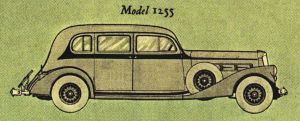- Home
- About Us
- Join/Renew
- Member Benefits
- Member Pages
- Log In
- Help
- Museum Store
All fun guesswork at this point but I always thought it peculiar that the 1934/35 models names didn’t match the wheelbases. Have speculated in earlier posts that the scuttled Studebaker-based line-up might have been the reason but am now wondering if the names tie directly to the line-up that the new owners created, off by one very interesting inch and missing one body style.
We know the ’34 “840/1240†and ’35 “845/1245†names were used for the 139 and 144 chassis while the ’34 “1248†and ’35 “1255†was used for the 147 chassis. But why?
It might have been that all the names were initially intended to be used for both years, perhaps with an “A†after the ‘34s and a “B†after the ‘35s or some other slight name change. Were this the case, 840/1240 might have been intended for the 139 chassis only, 845/1245 for the 144 chassis and the 1248 for the 147 chassis. Plausible enough but why were they off by 1 inch? The reason might go back to Studebaker, which bumped its wheelbases up one inch for 1935 even though the bodies and fenders were carried over, and the only reason I can think of as to why was the new independent front suspension, which might have located the front axle one inch forward relative to the firewall. Had Pierce-Arrow also intended its ’35 models to get a new independent front suspension, perhaps even based on Studebaker’s, then its wheelbases presumably would have increased an inch as well, now aligning all chassis correctly with the names.
This is all well and good except for one thing… where did “1255†come from? Methinks Pierce might have originally wanted to create a stylish top-of-line 7-passenger car using the Club Sedan’s more racy rear sheetmetal. If so, to create sufficient rear legroom to package the auxiliary seats the wheelbase would have needed to grow by several inches beyond the 147 chassis, and 7 seems about right. This would have required development of a new 154 inch chassis for ’34 that would have grown to 155 for ’35 due to IFS. That such a car might have been contemplated is not without basis: Pierce offered a similar rear design for some of its ’38 7-pass models (and ’37?). That such a new chassis was never tooled seems pretty obvious: projected volume would not have justified the effort.
Here’s a work-up with 5 inches added to club sedan’s front doors and 3 to its rear doors to get it from the 139 to 147 chassis, then moves the rear axle rearward 7 inches to bring it to 154. The extra roof length allows rear quarter windows to fit.

